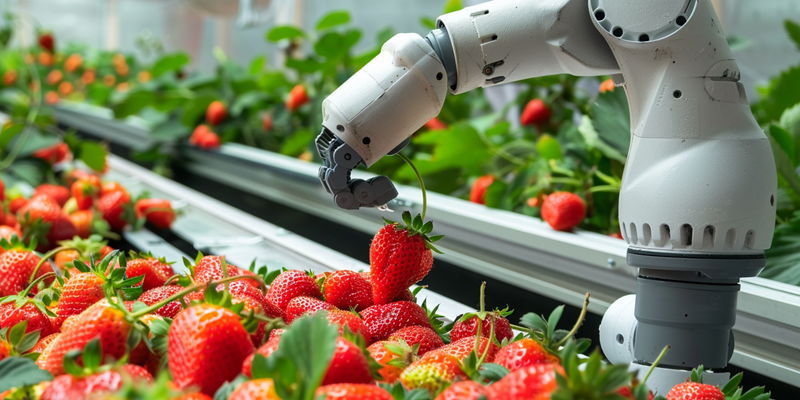Soft robotics and AI advancements are creating a new era in agriculture, particularly in the harvesting of delicate produce such as strawberries and tomatoes. This technological progression signifies a turning point in how farmers can address labor shortages, enhance productivity, and move towards more sustainable farming practices.
The Rise of Harvesting Robots in Agriculture
Soft Robotics and Delicate Produce
In the agricultural robot revolution, soft robotics is leading the charge with groundbreaking relevance for the picking of sensitive crops. The innovation lies in the development of flexible, supple grippers made from materials like silicone or rubber that can clutch fragile fruits without inflicting damage or bruising. This adaptability extends beyond harvesting to other field tasks such as pruning or pollination, which are traditionally done by hand.
These robots, equipped with dexterous grippers, are transforming how farmers manage crops by providing solutions to labor-intensive tasks with a level of precision human hands may struggle to achieve consistently. This breakthrough comes at a critical time, as a growing consumer demand for fresh produce collides with the scarcity of available and willing agricultural workers.
AI: The Brains Behind the Brawn
Integrating artificial intelligence into agricultural machinery allows these robots to autonomously identify ripe fruit for picking. Companies like Denso and Certhon have developed cutting-edge vision systems and machine learning algorithms that grant their robots, such as the Artemy, the capacity to distinguish ripe cherry tomatoes amidst a sea of unripe peers and navigate the vines with impressive accuracy.
Dogtooth Technologies takes this one step further with their robots equipped with AI-powered berry inspection systems. These robots are doing more than selecting ripe strawberries; they are evaluating each piece of produce against supermarket standards, picking only what satisfies the criteria for quality and size, ensuring that each berry meets consumer expectations before even leaving the farm.
Achieving Sustainability and Efficiency
Enhanced Productivity with Robotic Workers
Robotic workers are more than just stand-ins for human labor; they are a driving force for enhanced productivity. With robots like Dogtooth’s strawberry pickers and Denso’s Artemy designed to operate beyond a regular workday, farms can see a tangible uptick in their output. The game-changing factor is these robots’ ability to work uninterrupted, day and night, free from the constraints of human endurance.
This extended operation time not only means more work gets done, but it also leads to more consistent quality. Since these robots are less likely to make errors due to fatigue, there’s a considerable reduction in waste and an increase in the yield of premium-quality produce. What’s more, their precision picking can extend the shelf life of produce by ensuring optimal ripeness at the time of harvest.
Data-Driven Farming Insights
Agricultural robots are clever multitaskers, not only performing field labor but also capturing valuable data to propel farming into a more efficient future. With Dogtooth’s use of cloud-based software for data analysis and Artemy’s movable battery systems, these technologies are pioneering the way forward for smarter, more strategic crop management.
This trove of data and insights isn’t just helpful—it’s transformative for the farming industry. Armed with real-time information, farmers can make better-informed decisions that optimize their practices, from determining the perfect planting density to the most effective watering schedules. As a result, robots are at the forefront of elevating the science of farming to new heights of efficacy and sustainability.
The Future of Farming: Real-World Implications
Overcoming Labor Shortages
Robots are presenting a viable answer to the agricultural labor shortage—a growing concern that threatens global food production. Companies like Dogtooth and Denso with robots that can tirelessly and diligently harvest crops offer a real-world solution. This technology is not just an innovation; it’s a necessity.
The deployment of these robots has significant implications for the workforce. These machines support human workers by taking on the more monotonous or physically demanding tasks, potentially reshaping the agricultural labor market to focus on roles that manage and maintain these advanced systems rather than doing the manual labor themselves.
Practical Considerations of Robotic Adoption
Advancements in soft robotics, coupled with breakthroughs in artificial intelligence, are propelling agriculture into a new age, particularly impacting the collection of fragile fruits like strawberries and tomatoes. This evolution in technology marks a significant milestone for agriculturalists facing labor shortages, striving to bolster productivity, and seeking to transition to more ecologically friendly practices. As robots become increasingly delicate and nuanced in their operations, mirroring the human touch, they are revolutionizing the way we approach the cultivation and harvesting of tender crops. The implementation of these smart machines not only promises to address the pressing need for manpower in the farms but also aims to reshape the agricultural landscape by fostering efficiency and promoting sustainability. By empowering farmers with these cutting-edge tools, we are on the cusp of redefining traditional farming methods, ensuring that agriculture remains a vital, yet progressive industry.

